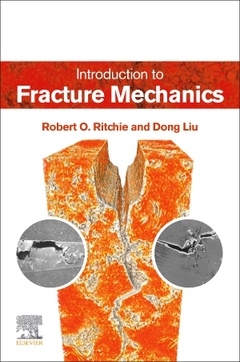Description
Introduction to Fracture Mechanics
Authors: Ritchie Robert O., Liu Dong
Language: English
Subject for Introduction to Fracture Mechanics:
Keywords
KIc fracture toughness; 1/r; Active-path corrosion; CCeramic fatigue; Ceramics; Characterizing parameter approach; Cleavage; Composites; Constraint; Corrosion fatigue; Crack closure; Crack resistance curves; Crack-growth toughness; Crack-tip constraint; Crack-tip opening angle; Crack-tip opening displacement (CTOD) singularity; Crack-tip shielding; Crack-tip stress singularity; Creep crack growth; Creep; CTOD as a fracture criterion; Cyclic plasticity; Damage-tolerant design; Damage-tolerant life prediction; Deflected cracks; Energy approach to fracture; Environmentally assisted cracking; Environmentally assisted fracture; Failure by yielding versus fracture; Fatigue crack growth; Fatigue striations; Fatigue threshold; Fatigue; Fracture mechanics; Fracture mechanisms; fracture toughness; Fracture; Griffith fracture theory; Hutchinson; Rice; Rosengren (HRR) singularity; Hydrogen embrittlement; Ideal fracture strength; Inclined cracks; Interface cracks; Intergranular cracking; Intrinsic vs; extrinsic toughening; J-based resistance curves; JIc; J-integral; J-solutions; KIc; KIscc; Leak-before-break; Length-scales; Load ratio; Measurement of CTOD; Measurement of growth rates; Mechanical heart valves; Medical prostheses; Metal fatigue; Metallic materials; Micromechanics modeling; Microstructural effects; Microvoid coalescence; Mixed-mode fracture mechanics; Model for strain-controlled ductile fracture; Nondestructive evaluation; Orowan fracture theory; Paris law; Plane stress vs; plane strain; Plastic-zone size; Polymeric materials; Prandtl field; Pre-tensioned bolts; Quasi-cleavage; Relationship to J-integral; RKR model for stress-controlled brittle fracture; Small cracks; Static modes; Steady-state creep; Strain-energy release rate; Stress corrosion; Stress-intensity factor; T-stress; Two-parameter fracture mechanics; Variable amplitude loading
168 p. · 15x22.8 cm · Paperback
Description
/li>Contents
/li>Biography
/li>Comment
/li>
Introduction to Fracture Mechanics presents an introduction to the origins, formulation and application of fracture mechanics for the design, safe operation and life prediction in structural materials and components. The book introduces and informs the reader on how fracture mechanics works and how it is so different from other forms of analysis that are used to characterize mechanical properties. Chapters cover foundational topics and the use of linear-elastic fracture mechanics, involving both K-based characterizing parameter and G-based energy approaches, and how to characterize the fracture toughness of materials under plane-strain and non plane-strain conditions using the notion of crack-resistance or R-curves.
Other sections cover far more complex nonlinear-elastic fracture mechanics based on the use of the J-integral and the crack-tip opening displacement. These topics largely involve continuum mechanics descriptions of crack initiation, slow crack growth, eventual instability by overload fracture, and subcritical cracking.
1. Introduction2. Foundation of Fracture Mechanics3. Linear-Elastic Fracture Mechanics (LEFM)4. Nonlinear-Elastic Fracture Mechanics (NLEFM)5. Crack-Tip Opening Displacement (CTOD)6. Micro-Mechanics Modeling of Fracture7. Application to Subcritical Crack Growth8. Practical Examples
Dr. Dong Liu is a Lecturer at the University of Bristol and she is the head of Experimental Mechanics of Advanced Materials (EMAM) Group. Her expertise lies in the multiple length-scale damage and fracture of nuclear and aerospace materials, not only in laboratory environments but also in their actual service conditions. Dr. Liu joined the University of Bristol as Lecturer in July 2018 from Oxford University (2015-2018) where she held an independent 1851 Exhibition Royal Commission Fellowship (Brunel) and an EPSRC postdoctoral research fellowship. Dr. Liu was also awarded a Junior Research Fellowship at Mansfield College (2016-2018) while at the University of Oxford.
- Presents how, for a given material, a fracture toughness value can be measured on a small laboratory sample and then used directly to predict the failure (by fracture, fatigue, creep, etc.) of a much larger structure in service
- Covers the rudiments of fracture mechanics from the perspective of the philosophy underlying the few principles and the many assumptions that form the basis of the discipline
- Provides readers with a "working knowledge" of fracture mechanics, describing its potency for damage-tolerant design, for preventing failures through appropriate life-prediction strategies, and for quantitative failure analysis (fracture diagnostics)
These books may interest you

Fracture Mechanics and Crack Growth 291.20 €

Mechanics of Fatigue 74.82 €


